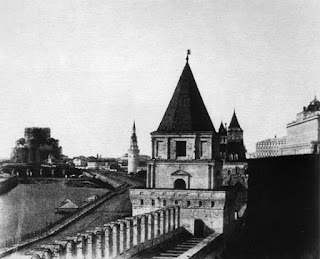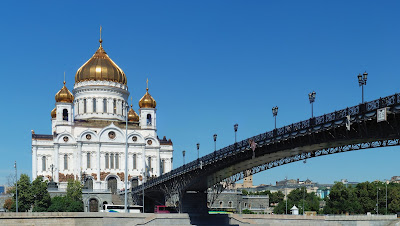|
Cathedral of Christ the
Saviour
|
|||
|
Храм Христа Спасителя
|
|||
|
|||
|
Location
|
|||
|
Country
|
|||
|
Website
|
|||
|
History
|
|||
|
26 May 1883;
reconsecrated 19 August 2000 |
|||
|
Architecture
|
|||
|
Specifications
|
|||
|
Dome
height (outer)
|
103 metres (338 ft)
|
||
The
Cathedral of Christ the
Saviour (Russian: Храм Христа
Спасителя, Khram
Khrista Spasitelya) is a cathedral in Moscow, Russia, on the northern bank of the Moskva
River, a few blocks southwest of the
Kremlin. With an overall height of 103 metres (338 ft), it is the tallest Orthodox Christian church
in the world.
The
current church is the second to stand on this site. The original church, built
during the 19th century, took more than 40 years to build. It was destroyed in
1931 on the order of the Soviet Leader, Joseph
Stalin. The demolition was supposed to make way for a colossal Palace of the Soviets to house the country's
legislature, the Supreme Soviet of the USSR. Construction
started in 1937 but was halted in 1941 when Nazi Germany invaded the Soviet Union during World
War II. Its steel frame was disassembled the following year, and the Palace
was never built. Following the dissolution of the Soviet Union, the current
church was rebuilt on the site during 1995-2000.
The
original church was the scene of the 1882 world premiere of the 1812
Overture composed by Tchaikovsky, which became internationally
famous.
INTERNET SOURCE: https://en.wikipedia.org/wiki/Cathedral_of_Christ_the_Saviour
Design
When
Napoleon Bonaparte retreated from Moscow, Tsar Alexander I signed a manifest on
25 December 1812 declaring his intention to build a cathedral in honor of
Christ the Savior "to signify Our gratitude to Divine Providence for
saving Russia from the doom that overshadowed Her" and as a memorial to
the sacrifices of the Russian people.
It
took some time for work on the projected cathedral to get started. The first
finished architectural project, by Aleksandr Lavrentyevich Vitberg,
was endorsed by the Tsar in 1817. It was a flamboyant Neoclassical
design full of Freemasonic symbolism. Construction work was begun on the Sparrow
Hills, the highest point in Moscow, but the site proved unstable.
In
the meantime Alexander I was succeeded by his brother Nicholas I. Profoundly Orthodox and patriotic,
the new Tsar disliked the Neoclassicism and Freemasonry of the design selected
by his predecessor. He commissioned his favorite architect Konstantin
Thon to create a new design, taking as his model Hagia
Sophia in Constantinople, Turkey. Thon's Russian
Revival design was approved in 1832. A new site closer to the Moscow
Kremlin was chosen by the Tsar in 1837. A convent and church on the site
had to be relocated, so the cornerstone of the new church was not laid until
1839.
Construction
The
cathedral took many decades to build; the scaffolding was not taken down until
1860. Its painting was overseen by Evgraf Sorokin, and thereafter some of
the best Russian painters (Ivan Kramskoi, Vasily
Surikov, V. P. Vereshchagin) continued to
embellish the interior for another twenty years. The cathedral was consecrated
on 26 May 1883, the day before Alexander III was crowned. Although Tchaikovsky's 1812
Overture was written with the building's completion in mind, it had its
world premiere in a tent outside the unfinished church in August 1882.
The
inner sanctum of the church (naos) was ringed by a two-floor gallery, its walls inlaid with
rare sorts of marble, granite, and other stones. The ground floor of the
gallery was a memorial dedicated to the Russian victory over Napoleon. The
walls displayed more than 1,000 square metres of Carrara bianca
marble plaques listing major commanders, regiments, and battles of the Patriotic War of 1812 (with the lists of
awards and casualties appended). The second floor of the gallery was occupied
by church choirs.
The
giant dome of the
cathedral was gilded using the new technique of gold electroplating,
replacing the older and insecure technique of mercury gilding.
Demolition
Under
the state
atheism espoused by the USSR, many "church institution[s] at [the]
local, diocesan or national level were systematically destroyed" in the 1921-1928 anti-religious
campaign. After the Revolution and, more specifically, the
death of Vladimir Lenin, Soviet
leader Joseph Stalin chose the prominent site of the
cathedral as the proposed site for a monument to socialism known as the Palace of the Soviets. It was to have modernistic,
buttressed
tiers to support a gigantic statue of Lenin perched on top of a dome with his
arm raised in the air.
The
economic development in Russia during the 1930s required more funds than the
government had at the time. On 24 February 1930, the economic department of the
OGPU sent a letter to the Chairman of the Central Executive Committee asking to
remove the golden domes of the Christ the Saviour Cathedral. The letter noted
that the dome of the church contained over 20 tons of gold of "excellent
quality", and that the cathedral represented an "unnecessary luxury
for the Soviet Union, and the withdrawal of the gold would make a great
contribution to the industrialization of the country." The People's
Commissariat of Finance did not object to this proposal.
On
5 December 1931, by order of Stalin's minister Kaganovich,
the Cathedral of Christ the Saviour was dynamited and reduced to rubble. It
took more than a year to clear the debris from the site. Some of the marble
from the walls and marble benches from the cathedral were used in nearby Moscow
Metro stations. The original marble high
reliefs were preserved and are now on display at the Donskoy
Monastery (see the photo).
For a long time, these were the only reminders of the largest Orthodox church
ever built.
The
construction of the Palace of Soviets was interrupted owing to a lack of funds,
problems with flooding from the nearby Moskva
River, and the outbreak of World War II. The flooded foundation hole
remained on the site. Under Nikita
Khrushchev, it was transformed into the world's largest open air swimming
pool, named Moskva Pool.
Rebuilt
cathedral
In
February 1990, the Russian Orthodox Church received permission
from the Soviet Government to rebuild the Cathedral of Christ the Saviour. A
temporary cornerstone was laid by the end of the year. The restorer Aleksey Denisov was called
upon to design a replica of extraordinary accuracy. A construction fund was
initiated in 1992 and funds began to pour in from ordinary citizens in the
autumn of 1994.
In
this year the pool was demolished and the cathedral reconstruction commenced.
About one million Muscovites donated money for the project. There are still
arguments about the reconstruction. First the project was supervised by
architect Aleksey Denisov. Soon he was
fired from the project because of disagreements with the Mayor’s office.
When
construction was well under way, Denisov was replaced by Zurab
Tsereteli, who introduced several controversial innovations. For instance,
the original marble high reliefs along the walls were replaced by modern bronze
ones, which have few, if any, parallels in Russian church architecture. The lower church
was consecrated
to the Saviour's Transfiguration in 1997, and the completed Cathedral of Christ
the Saviour was consecrated on the Transfiguration Day, 19 August 2000.
A
footbridge across the river from Balchug was constructed between 21 June 2003 and 3 September
2004 (photo). On the
slope of the hill to the right of the cathedral are the monumental statues of Alexander
II and Nicholas II. The cathedral square is graced
by several chapels, designed in the same style as the cathedral.
In
2000 the cathedral was the venue for the Canonization of the Romanovs when the
last Tsar Nicholas II and his family were glorified
as saints. On 17 May 2007, the Act of
Canonical Communion between the Moscow Patriarchate of the Russian Orthodox
Church and the Russian Orthodox Church Outside
Russia was signed there. The ROCOR had been separate since the 1920s. The
full restoration of communion with the Moscow Patriarchate was
celebrated by a Divine Liturgy at which the Patriarch of Moscow and All Russia,
Alexius II and the First Hierarch of ROCOR, Metropolitan Laurus, concelebrated the Divine
Liturgy for the first time in history.
The
first Russian President Boris Yeltsin, who died of heart failure on 23 April
2007, lay in state in the cathedral prior to his burial in Novodevichy Cemetery.
In
2009 the cathedral was visited by Metropolitan Jonah (Paffhausen), former primate of the Orthodox Church in America, who
celebrated the Liturgy with Patriarch Kirill I. Metropolitan Jonah later
described the event, saying that even with a congregation of approximately
2,500, the vast church was only half full. About 16 bishops attended the
ordination of a new bishop that day. Below the new church is a large hall for
church assemblies.
In
2012, five members of the rock band Pussy Riot
staged an uninvited performance in the Cathedral, expressing irreligious
expressions of political opinions critical of the government. The members were
arrested and jailed.
 |
|
The service was held in Moscow's Christ the
Saviour Cathedral (AP Photo/Alexander Zemlianichenko)
|







No comments:
Post a Comment